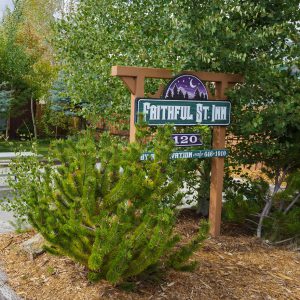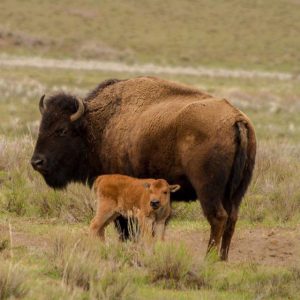Mysterious Wonders
The Yellowstone Story began long before it was officially discovered. Fur trappers entered the area in search of furs but also out of curiosity. They’d heard and spread tales of petrified forests, hot and cold water in the same stream, rainbow-colored hot springs, water shooting high into the air, and boiling mud. Although Lewis and Clark passed nearby, they never actually entered what today is Yellowstone National Park. However, one of their members, John Coulter, left the Corps Of Discovery on its way back to St. Louis and set out to find these mysterious wonders. Eventually, these tales spread throughout all of North America. And, entrepreneurs, prospectors, scientists, and outlaws alike were intrigued by the promise of a land so full of wonder. Free enterprise began to rule. As such, numerous unauthorized tent camps, poacher’s cabins, and transient settlements showed up. Soon after, railroads began building track and planning for expansion. Everyone wanted to see Yellowstone.
A National Park is Born
Finally, the United States Congress sent an official expedition to search for truth in the Yellowstone story. Complete with photographs by William Henry Jackson and sketches by Thomas Moran, the expedition’s report resulted in our first national park. In 1872, an act of Congress established a “public park and pleasuring ground” for the “benefit and enjoyment of people.” As no money was set aside to administer the park and its superintendent was not on scene, law and order was nearly impossible. Rules were promulgated and immediately ignored. And, the magnetic attraction that paradise could be despoiled with no consequences (an attitude that persists to this day) soon developed. It was a park and pleasuring ground for any interest or pursuit that could be imagined by any person or group. It must have been a glorious chaos.
The Army Arrives
After some years and deliberation about just what they had created, the powers that be decided that the U.S. Army should be utilized to “tame” the park. After all, the Army had tamed the West; surely they could tame this pleasuring ground as well. So, the Yellowstone story continued.
In 1886, Captain Moses Harris of the First United States Cavalry marched 50 men to Yellowstone National Park. After assuming the superintendency, he established a tent camp at the foot of the Mammoth Hot Springs terraces. Overnight, administrative power shifted from the civilian hands that created the park to military hands. On his second day as superintendent, Captain Harris issued a general order and the guidelines for enforcing it - the first ever enforceable framework for administration of the park. Quickly, the chaos became subdued. The common practice of hunting became poaching, visiting became trespassing, collecting firewood became unauthorized logging, a pleasant evening campfire became an unauthorized conflagration, and selling fish to the hotels became a crime of theft and larceny (and poaching).
With the Army present, the railroads built grand hotels and concessionaires built modest emporia with the security that they would be protected from robbers and other nefarious adventurers. Though, stagecoaches were still robbed and traveling was still an adventure, Yellowstone became a destination on the American Grand Tour for the upper class. The Army maintained control for 20 years until its withdrawal in 1916 when the National Park Service was created.
A democratizing force - Automobiles
The first automobile - a democratizing force - traveled to West Yellowstone in 1913. For a time, there were competing modes of travel by horse, foot, stagecoach, and railroad. Each required different accommodations and each attracted different sorts of people. Tough decisions were heaped upon the National Park Service as they continued to write the Yellowstone Story. Where should they put roads, gas stations, and parking lots? How should camping sites to be regulated? Should they regulate visitation and hotel construction? How should fees be structured and who was entitled to them? Should free enterprise be regulated in the park? Yellowstone National Park became, more so than before, the test case for these questions, and many more. As the automobile slowly became the preferred mode of travel for visitors, no longer could the railroad script visitations and dictate travel and meal times (and charge for both). The railroads gradually abandoned passenger service to Yellowstone. By the end of the 1960s and into the 1970s, the park was essentially a summer destination visited by automobile.
Yellowstone in Winter
Though winter visitors, keepers, and rangers had existed since about 1919, the discovery of Yellowstone as a winter destination began to gather steam in the post war years with the invention of snow planes. From the 1960s forward, intrepid skiers, snow planers, and, eventually, snowmobilers persisted in visiting the park - especially from the west entrance in West Yellowstone. Much like in the early days of stagecoach travel, the first over-snow travelers found themselves with free rein of the park. Though there were initially few winter visitors, those that came fed the wildlife and the snow vehicles traveled where they pleased. With the winter use demand from the public, the park was again forced to contend with access. Snow on the summer roads was groomed for easier and controlled travel, the park concessionaire provided lodging inside the park, and eventually winter visitation grew. As park management philosophies changed, so did winter travel. Currently, the majority of winter travel is limited to guided snowmobile and snowcoach tours, and even their numbers are regulated.
Protecting the Park
Most recently, there has been talk of restricting summer travel. Park roads and facilities have become over-run in the summer months causing traffic back ups, resource damage from lack of enough parking, and there just isn’t enough funding to staff the National Park Service tasked with protecting the park. Their directive (from The Organic Act of 1916) “to conserve the scenery and the natural and historic objects and the wild life therein and to provide for the enjoyment of the same in such manner and by such means as will leave them unimpaired for the enjoyment of future generations” continues to be a challenging one: How do you allow for enjoyment while still leaving it unimpaired?


